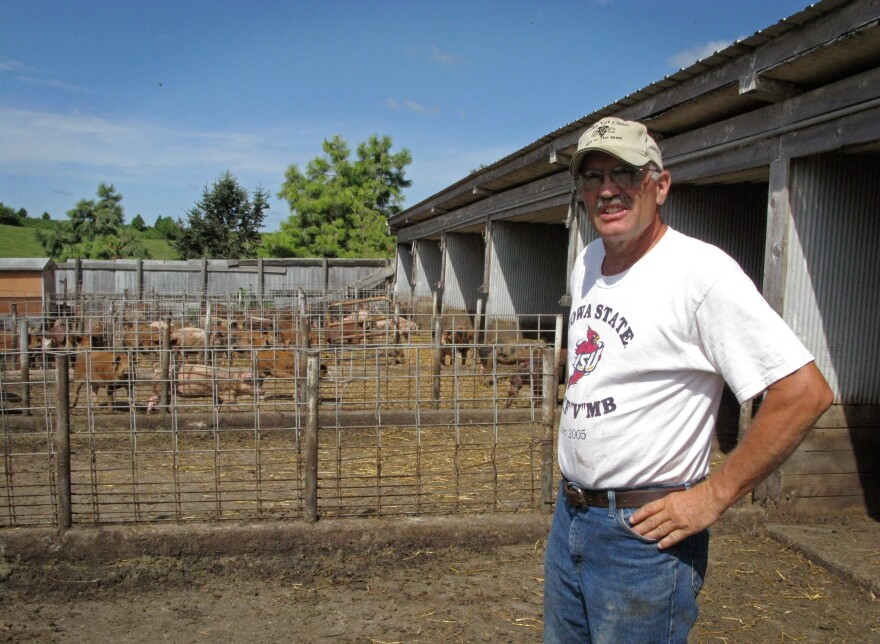Back in the spring, farmers who raise pigs were in a panic. Many major customers, such as food service companies that supply restaurants, weren't buying pork. Prices had fallen sharply. Some hog farmers had no place to ship their animals because so many workers in pork processing plants got sick from COVID-19.
"Our folks need a lifeline," said Nick Giordano, top lobbyist for the National Pork Producers Council, on a call with journalists in May. "Unless there is a large cash infusion from the federal government, we're going to lose a lot of producers."
Other farmers also demanded government aid. They got their wish.
Congress approved about $35 billion in emergency aid to farmers, which came on top of roughly $10 billion in traditional farm subsidies that were already in place. In addition, farmers were able to tap billions of dollars in funding from the Paycheck Protection Program.
The aid, delivered in two separate packages over the course of the year, went to a wide variety of people in agriculture, including corn and soybean farmers, cattle ranchers, and fruit and vegetable producers. The $46 billion in direct government payments to farmers in 2020 broke the previous annual record by about $10 billion, even after accounting for inflation.
"You almost lose track of how much money is going out," says Joseph Glauber, formerly the U.S. Department of Agriculture's chief economist, now a senior research fellow at the International Food Policy Research Institute.
Yet as the flood of money continued through the summer and fall, most farmers' economic worries were receding. "Commodity prices have come back up and actually are looking better than they've looked in several years," Glauber says.
Total U.S. farm income in 2020 would have been about average, compared with the past 20 years, even without the emergency aid. The massive government payments turned it into the fifth-most profitable year since 1975.
Farmers didn't have to prove that they needed help in order to qualify for subsidies. They simply got paid based on their previous production of grain or pigs or cattle. The more crops they grew, the more government money they got, up to a cap of $250,000 per person. Up to three partners in any enterprise could collect that maximum amount.
Final figures aren't yet available, but based on previous years, it's likely that most of the money went to fewer than 100,000 farms. "I think there is a fundamental question: Why are we providing all this additional aid?" Glauber says.
Farmers contacted by NPR had a variety of answers to that question. Chad Leman, co-owner of a large hog farm in central Illinois, says the federal aid kept some pork producers from going under. "You would have seen significant fallout had there not been some assistance," he says.
Leman's farm received more than $700,000 in government payments in 2020, according to USDA data obtained by the Environmental Working Group, a long-time critic of many farm subsidies.
Leman's government aid was limited by the cap on payments to any single enterprise, and Leman says his farm still will lose money this year. "None of us expect to be made whole" from pandemic-related losses," says Leman. "Our ask was, 'Help us get to the next year.' So I'm grateful for what has been done."
The EWG regularly publishes the names of wealthy and well-connected people who've received farm subsidies. They include members of Congress who vote on such payments. Sen. Kelly Loeffler of Georgia, for instance, who is currently campaigning to keep her seat in the Senate, owns a share in a family farming enterprise that, according to EWG figures, received more than a million dollars in federal subsidies over the past two years.
Other farmers, who declined to be named, said they were glad to get the money and embarrassed at having to rely on government payouts.
Ron Rosmann, an organic farmer in western Iowa, says his neighbors rarely talked about the payments, but sometimes made jokes about them. He recalls overhearing one group of older farmers as they played cards. "I heard one guy say, 'Yep, got another check from the government today. Didn't need it, but boy! I don't know what to do with it!'"
Rosmann got some of this money himself, yet he says he's not in favor of the program. "It has disproportionately gone to the largest producers," he says. The move continues to fuel the trend of large farms growing bigger, outbidding smaller farmers when land comes up for rent or for sale.
That, in turn, means fewer people in rural communities, and less life in small towns. It seems paradoxical, but according to Rosmann, passing out money to farmers this way can actually hurt farming communities. "We just continue to fight a declining and aging population out here," Rosmann says.
Yet more money may be on the way. The latest coronavirus relief package, just approved by Congress, contains another $8 billion in payments to farmers.
Copyright 2021 NPR. To see more, visit https://www.npr.org.




